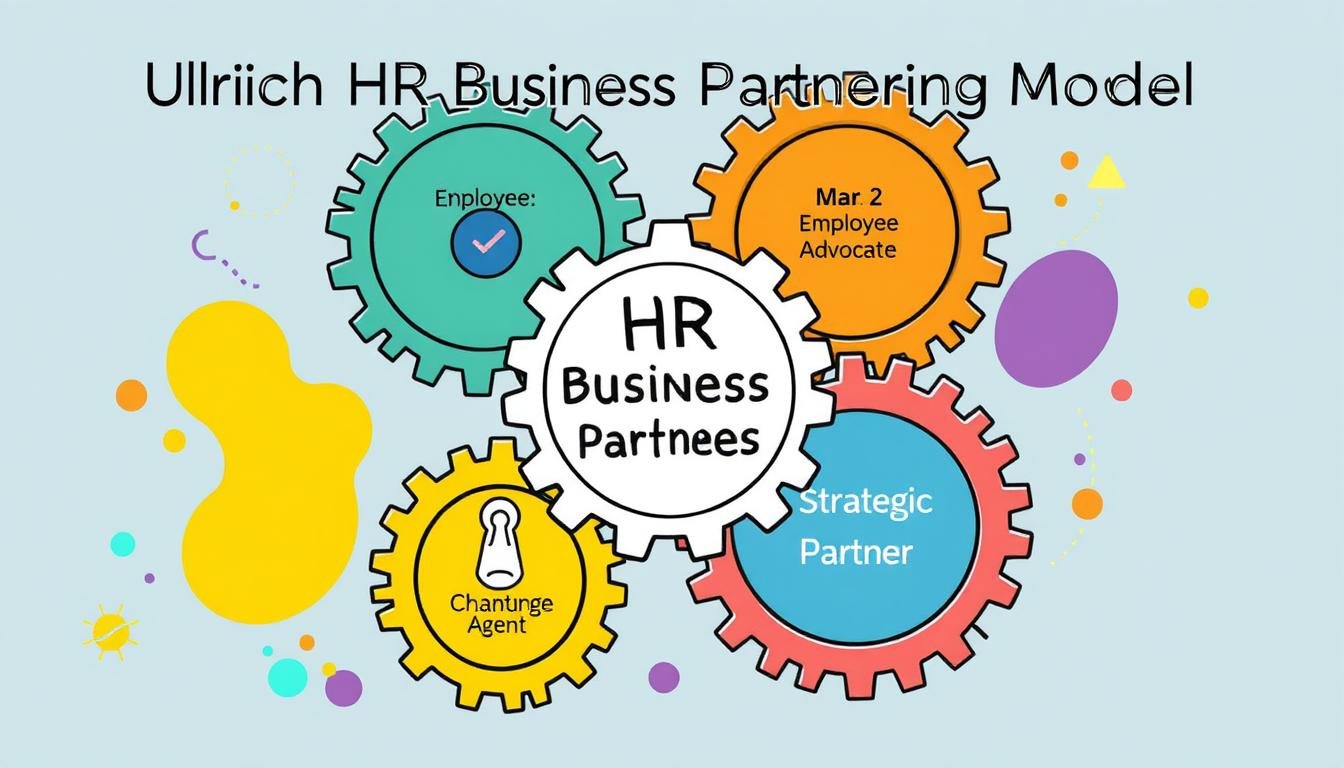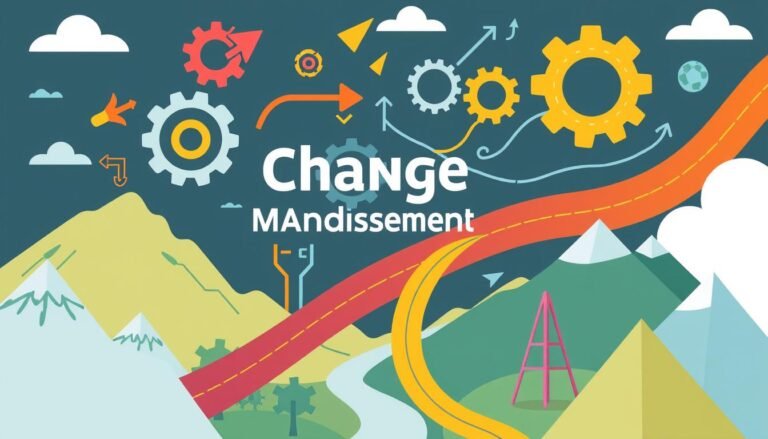Deep Dive into the Ulrich HR Business Partnering Model
The Ulrich HR Business Partnering Model has changed HR since the 1990s. It makes HR departments more strategic and focused on Talent Management. Now, HR does more than just admin tasks; it drives business success.
Dave Ulrich’s framework aligns HR with company goals. It encourages teamwork and flexibility, making it popular. The model divides HR into three parts: shared service centers, centers of excellence, and HR Business Partners (HRBPs).
Despite its success, the model faces challenges. Bad implementation and management can cause problems. It’s key to customize the approach for each organization’s needs. Success in HR business partnering needs careful planning and execution.
The Ulrich model is evolving with the digital era. Modern HR must use new technologies like AI and data analytics. This change is making HR roles more proactive in solving business problems. The future of HR is exciting, focusing on customer value and data-driven decisions.
Key Takeaways
- The Ulrich model promotes strategic HR roles
- Successful implementation requires tailored approaches
- Metrics are crucial for measuring HR effectiveness
- Digital technologies are reshaping HR functions
- HR must balance employee well-being and business competitiveness
- Data analytics is becoming central to HR decision-making
Understanding the Ulrich Model Framework
The Ulrich Model is a key part of HR Competency Models. It has changed how we think about Organizational Development. Developed by Dave Ulrich, it shows a new way for HR to help businesses succeed.
Origins and Evolution of the Ulrich Model
Dave Ulrich created this model to change HR practices. The Ulrich HR Academy offers a 6-week program with 16 modules. It covers important topics like HR from the Outside-In and Outcomes of HR.
Each week, there are 60-minute sessions. They focus on key areas to help professionals learn.
Key Components of the Model
The Ulrich Model has three main parts:
- HR Shared Services
- HR Centers of Excellence
- HR Business Partners
This setup, known as the “three-legged stool,” aims to make HR work better. It helps HR have a bigger impact on the business.
Primary Objectives of HR Business Partnering
HR Business Partnering aims to make HR work with business goals. A survey found that 85% of global companies see HR transformation as key to meeting new business needs. The High-Impact HR model, based on Ulrich’s work, has shown great results:
| Impact Area | Improvement Factor |
|---|---|
| Adapting to market changes | 2.5x more likely |
| Creating new products quickly | 2.4x more likely |
| Operating efficiently | 2x more likely |
| Winning over competition | 2x more likely |
These numbers show how good HR practices can really help a business. They prove the Ulrich Model’s value in today’s business world.
Roles and Responsibilities of HR Business Partners
HR Business Partners are key in today’s HR service delivery models. They connect strategy with people solutions, helping businesses succeed. They manage human resources effectively.
The Strategic Role in Organizations
HR Business Partners align HR with business goals. They prepare for the future of work, using business skills to gain an edge. They empower leaders and make decisions based on data, helping the organization thrive.
Day-to-Day Responsibilities
HR Business Partners do many important tasks every day. They advise and coach managers on talent and growth. They also improve employee experience and culture, boosting engagement and productivity.
- Developing and implementing HR strategies
- Analyzing workforce data to inform decision-making
- Addressing employee relations issues
- Facilitating organizational change initiatives
Collaboration with Other Departments
HR Business Partners work closely with other teams. They team up with finance to match HR budgets with business goals. They also work with marketing to improve employer branding and support operations in planning the workforce. This teamwork ensures HR fits into the business strategy.
“HR Business Partners are the linchpin in translating organizational strategy into effective people solutions, driving engagement, productivity, and ultimately, business success.”
The Four Key Roles of HR Professionals
The Ulrich Model highlights four essential roles for HR professionals. These roles are the backbone of modern HR Centers of Expertise and HR Shared Services. Let’s dive into each role and its role in organizational success.
Administrative Expert
HR professionals focus on making operations run smoothly as administrative experts. They improve processes, manage HR systems, and keep things running day-to-day. This role is crucial in HR Shared Services, where being efficient and cost-effective is key.
Employee Champion
HR professionals act as champions for employees, standing up for their needs and concerns. They create programs to boost morale, help with work-life balance, and build a positive work culture. This role is vital in building trust between employees and management.
Change Agent
In today’s fast-paced business world, HR professionals must lead change. They help companies adapt to new market conditions and technologies. This role is especially important in HR Centers of Expertise, where innovation is crucial.
Strategic Partner
As strategic partners, HR professionals align HR strategies with business goals. They work with leadership to develop workforce plans that support company objectives. This role elevates HR from a support function to a key driver of business success.
By fulfilling these four roles, HR professionals play a big part in organizational performance. They balance operational needs with strategic initiatives. This ensures that HR Centers of Expertise and HR Shared Services add value across the organization.
Benefits of Implementing the Ulrich Model
The Ulrich Model offers great benefits to companies looking to transform their HR. It makes HR practices match business goals, leading to big improvements.
Enhanced Organizational Performance
Companies see a rise in performance with the Ulrich Model. It shapes HR processes and defines roles, making decisions better and operations smoother.
Improved Employee Engagement
The Ulrich Model boosts employee engagement. It creates a work environment where employees are empowered, leading to better job satisfaction and productivity. They feel more connected to the company’s mission.
Greater HR Efficiency
This model makes HR more efficient. It introduces roles like HR Shared Service Centers and HR Business Partners. This leads to quicker decisions and tailored solutions for each department.
| Benefit | Impact |
|---|---|
| Aligned HR Practices | Better support for business goals |
| Clarified Roles | Increased HR team effectiveness |
| Empowered Workforce | Higher productivity and satisfaction |
| Specialized HR Functions | Improved service delivery |
The Ulrich Model is a top choice for aligning HR with business goals. It offers a framework for ongoing learning and adapting, key in today’s fast-changing business world.
Challenges in Adopting the Ulrich Model
The Ulrich Model has been a big influence on HR since 1997. But, it’s not easy for companies to adopt it. They face many obstacles that affect HR Competency Models and Organizational Development.
Resistance to Change
HR pros and managers often don’t want to change to the Ulrich Model. They’re used to their old ways and worry about new tasks. To get past this, it’s important to explain the model’s benefits clearly and train everyone well.
Misalignment with Organizational Goals
At times, the Ulrich Model doesn’t match a company’s goals. This can cause confusion and make it hard to use the model right. To fix this, companies need to make the model fit their own plans and culture.
Limited Resources and Support
Using the Ulrich Model needs a lot of resources. Many companies don’t have enough money or support from the top. This can make it hard to use the model well and slow down growth.
| Challenge | Impact | Potential Solution |
|---|---|---|
| Resistance to Change | Slows adoption, reduces effectiveness | Comprehensive training, clear communication |
| Misalignment with Goals | Confusion, ineffective implementation | Customize model to fit organization |
| Limited Resources | Hinders effectiveness, slows development | Secure executive support, prioritize initiatives |
Even with these challenges, many companies do adopt the Ulrich Model. The secret is to make the model fit their specific needs, tackle resistance early, and get the right resources for a smooth rollout.
The Impact of Technology on HR Business Partnering
Technology has changed how HR Business Partners work. In today’s world, using HR tech is key to staying ahead. It makes HR work more efficient and effective.
Leveraging HR Tech Solutions
HR Shared Services have improved a lot with technology. New systems make tasks like payroll and employee data easier. This lets HR Business Partners focus on big plans, not just day-to-day work.
Data-Driven Decision Making
Analytics have given HR a big boost. Now, HR Business Partners can make smart choices with data. They look at KPIs to plan better, improving the whole team’s work.
Enhancing Communication and Collaboration
Technology helps HR talk better with other teams. Digital tools let HR Business Partners work with others closely. This teamwork creates solutions that fit each department’s needs.
As HR keeps growing, using technology is essential. With these tools, HR Business Partners can lead important projects. They help the company grow in big ways.
Best Practices for Effective Implementation
To make the Ulrich Model work, you need a smart plan for HR change and talent care. Companies should follow key steps for a smooth shift. This way, they can get the most out of this model.
Training and Development for HR Teams
Teaching HR teams is key for HR change. They need training in strategic thinking, data analysis, and business knowledge. This helps them meet company goals and lead real change.
Establishing Clear KPIs
To see if talent plans are working, set clear goals. These goals should track things like employee happiness, how well they stay, and how productive they are. This lets HR show their value and make choices based on facts.
Fostering a Collaborative Culture
Building a team that works together is vital for HR success. This means breaking down walls between teams and talking openly. HR should team up with managers and leaders to understand needs and create solutions that help the company.
| Best Practice | Impact on HR Transformation |
|---|---|
| Continuous Learning | Boosts HR team skills |
| Data-Driven Decision Making | Better talent plans |
| Cross-Functional Collaboration | Aligns HR with company goals |
By using these best practices, companies can put the Ulrich Model into action well. This not only improves talent care but also makes HR a key player in business success.
Case Studies of Successful Ulrich Model Implementation
The Ulrich model has changed HR for over 20 years. We’ll look at how top companies have used it. We’ll see what they learned and the results they got.
Insights from Leading Companies
PricewaterhouseCoopers (PwC) is a great example. They plan for most UK employees to work from home some days after the pandemic. This fits the Ulrich model’s goal of better connection between HR and business.
Lessons Learned and Common Pitfalls
Companies have faced hurdles with the Ulrich model. One big lesson is the need to adapt to digital work. With 75% of office workers using new tech since lockdown, HR must keep up. Common issues include resistance to change and not aligning with company goals.
Measurable Results and Success Indicators
The Ulrich model brings clear benefits. 69% of people say it has made their company culture better because of changes from the pandemic. This matches the model’s aim for better employee engagement and HR work. Also, 98% of people want to work from home, showing the model’s flexibility.
| Success Indicator | Percentage |
|---|---|
| Positive cultural impact | 69% |
| Desire for remote work options | 98% |
| Effective executives in closing skills gap | 28% |
These examples show the Ulrich model can really help HR and improve companies. It leads to better performance and happier employees.
The Future of HR Business Partnering
The world of HR is changing fast, with big changes happening everywhere. HR business partners will play a key role in leading these changes. They will help drive important HR strategies and create a lively work environment.
Emerging Trends in HR Practices
HR experts are using data and analytics more than ever. At Transport for New South Wales, the Chief People Officer aims to make it the best place to work by 2029. This shows how important it is to use evidence in HR and track progress towards goals.
Adapting to a Hybrid Workforce
Remote work has become common, with 46.6% of the UK’s workforce working from home in April 2020. By the end of 2021, 25-30% of the US workforce will work remotely often. HR business partners need to make sure everyone, whether at home or in the office, feels connected and productive.
The Evolving Role of HR Professionals
HR professionals are now key players in helping companies succeed. They need to understand the business strategy and what each team needs. With companies like PwC and Goldman Sachs adopting flexible work, HR must focus on keeping employees happy and engaged.
Studies show that employees in spaces with natural features are 15% happier and 6% more productive. This shows how important it is to design workplaces that support well-being and productivity.
Source Links
- Don’t Blame the Ulrich Model – Jon Ingham Strategic HR Academy
- Dave Ulrich: HR need not be your friend to be effective
- Time to turn the Ulrich Model into a Digital Delivery Model – Connecting Hr with Australia
- Updating the HR Operating Model [11 Elements of a New Model]
- The Dave Ulrich HR Academy
- 9064357 USAID Center for Global Development Innovation Proposal
- Employee Engagement
- The best HR and People Analytics articles of April 2019 | myHRfuture
- What is the role of HR in helping companies plan effectively for the future of work?
- The Evolution of the HR Business Partner
- 8 General Human Resources Management Models and Perspectives
- What Is HR Strategy?
- Josh Bersin’s Systemic HR Model reviewed by Jon Ingham
- Transforming the HR Operating Model for Greater Impact
- Navigating the Future: The Dual Evolution of Strategic and People-Centric HR – The HR World Magazine
- HR Business Partner Model
- Why Strategic Partnering – Jon Ingham Strategic HR Academy
- HRD Deep Dive: Reimagining the office for the future of work – HRD
- HR Strategy – Fade to black








